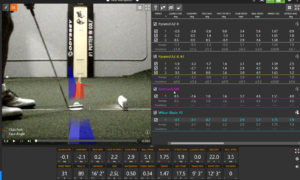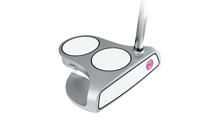Blade style? Mallet? Face Balanced? Toe Hang? How do you select which putter is best for you?
CLICK HERE TO SCHEDULE YOUR FITTING
We now have the TrackMan Performance Putting analysis software that allows us to look at a lot of data that will affect your putting performance. How consistent is your stroke? What is your alignment to target and launch direction? How soon does the ball start rolling instead of bouncing or skidding to its target? Schedule a TrackMan putter fitting and find out how we can improve your putting!
I went from a 15 to a 10 handicap in a little over a year since working with you guys to get all of my clubs matched. The irons especially are really dialed in. -Jay R., Lakewood, CO (January, 2010).
The following factors should be considered when choosing a putter. Some are more important than others and for some golfers, just the appearance of the putter can create more confidence.
There are two major aspects to putter fitting:
Putter Fitting Aesthetic and Human Factors:
- Alignment Aids (lines, two ball, etc.)
- Color
- Eye Dominance (Left or Right)
- Look (Blade, Wide Blade, Mallet, Small Mallet, etc.)
These factors are part of the initial fitting discussion even before we get to rolling a few putts on our putting surface. Of critical importance is Eye Dominance as it can affect both Alignment to target and swing path. Click here for a simple way to determine eye dominance.
Putter Fitting Equipment Factors:
- Length
- Loft
- Lie Angle
- Grip Size
- Overall Weight
- Balance (Swing Weight)
- Toe Hang
- Style (Blade, mallet)
Length:
Your putter length should put your eyes over the ball or just slightly inside the ball. If you are too far inside or on top of the ball, your ability to see the putting line will be impaired and you could push or pull your putts. Standard length putters are anywhere from 30″ to 36″ but can be any length.
Loft:
Putter lofts are usually 3 or 4 degrees. This loft allows the ball to get rolling quickly on the green in order to track the putting line more accurately. Too low of loft and the ball will bounce off the putter face. Too high of loft and the ball will skid and not roll accurately towards the target. Your hand position at impact can be a large factor in what loft you should have on your putter. If you forward press, you should have slightly higher loft. Speed of the greens also is a factor. Faster greens require lower loft while slower greens dictate higher loft.
Lie Angle:
If the lie angle of your putter is too upright or too flat, the putter will not contact the ball squarely and cause you to either pull or push your putts. This is best observed by a fitter or a fitting system as it is difficult to determine when you are in your putting posture. Sometimes your putter may appear “toe up” or “toe down” depending upon eye position and length of the putter.
Grip Size:
If you have a little too much wrist or hand movement in your putting stroke you will be inconsistent in your putting arc and face angle at impact. By trying a larger grip, you may reduce this hand and wrist action and become a lot more consistent. Winn and SuperStroke make oversize grips that do not impact the overall weight of the putter.
Overall Weight:
If your putter is too heavy or too light, you will struggle to make a consistent putting stroke. Every golfer has a different feel and finding the correct feel for you requires trying different putter weights and determining the impact on the consistency of your putting stroke.
Balance (Swing Weight):
Just like swing weight has an impact on a golfer’s full swing clubs, the balance of a putter can also impact your ability to make consistent contact with the ball and make a consistent putting stroke. By trying putters with different weighting, like the Balance Certified weighting system, the golfer will be able to see the results of different weights on consistency.
Toe Hang:
Putters are designed as either face balanced or with a certain amount of toe hang. If you balance a putter horizontally on your fingers, with the face of the putter facing up, you will see how your current putter is designed. Most mallet style putters are face balanced, meaning they rest perfectly horizontal to the ground, while most blade style putters have a certain amount of toe hang, meaning the toe is slightly heavier and tips downward towards the ground. Face balanced putters are better for a putting stroke that is straight back and straight through. If you have a slight or pronounced arc in your putting stroke, you should consider a putter with slight to moderate toe hang to help square the face consistently.
Style – Mallet, Blade or Combo:
Putters come in a wide variety of styles from blade (Ping Anser style) to mallet (Odyssey Two Ball) and all kinds of variations in between. Your choice can be based upon what visually appeals to you as well as what fits your swing style (straight back and through or arc). Larger mallet styles have more forgiveness but have more “clutter” to look at. The neck style can also be important as it can visually help you align the face and ball to your target line.



